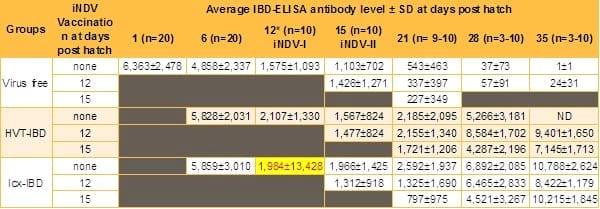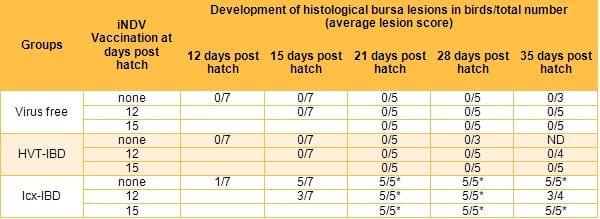Targeting immunosuppression - building a good immune foundation
Published: May 4, 2016
By: Dr. Dexter M. Abrigo
Summary
To counter immunosuppression in chickens, it is best to maintain the integrity of the bursa so as to maximise protection. Maintaining the bursal integrity not only provides for a solid immune foundation but also to provide barriers for other avian pathogens. This can be done with the use of a vector HVT+IBD (Vaxxitek HVT+IBD) vaccine applied at the hatchery either in ovo or at day old.
Introduction
Immunosuppression in poultry causes widespread and significant economic losses, by decreasing vaccine effectiveness, causing excessive post-vaccine reactions, and allowing secondary infections like E. coli to establish, requiring antibiotic treatment. Dexter M. Abrigo and Stephane Lemiere* explain how to reduce immunosuppression to build a good and solid immune foundation.
Exposure to stressors in the poultry production environment, along with infectious diseases (viral or bacterial) that impair immunity, contribute to an overall reduction in flock health, causing a decrease in productivity. Among the different viral diseases, infectious bursal disease (IBD), Marek’s and chicken infectious anaemia (CIA), are the mainly recognised and implicated viruses, causing direct negative effects on the immune system, thereby increasing susceptibility to other diseases and interfering with vaccinal immunity. It is therefore imperative, to reduce immunosuppression to enhance the immune system, and to establish barriers to the most common routes of infection by avian pathogens.
How to establish a good foundation?
A solid immune foundation not only enhances the immune system, but also prevents entry of other pathogens by establishing barriers. This can be done by passively protecting the progeny through breeder vaccination programs and by protecting growing chickens against immunosuppressive diseases, and their economic consequences. Many of the vaccinations performed in the field are being moved to the hatchery, which can be done either in ovo, as early as 18 days of embryonation, and at day-old of newly hatched birds. This early vaccination in the presence of maternal antibodies best induces a good immune foundation. One current trend is the use of turkey herpesvirus (HVT)-based vaccines that protect against Marek’s disease (MD), and other viral diseases such as IBD, Newcastle disease (ND) or infectious laryngotracheitis (ILT). In chickens, the B lymphocytes and antibody-producing plasmocytes originate from the bursa of Fabricius, making it the cornerstone of immunity. Damage to the bursa, usually associated with the IBD virus, causes immune depression. MD virus can also damage the bursa and early IBD viral infection lesions appear similar to early MD viral lesions. With the use of a vector HVT + IBD strain vaccine, the bursal health is significantly protected with measurable results on the humoral immune system as well as circulating and intra-bursal B cells.

Figure 1: Infected bursa of the Fabricus resulting in immunosuppression.
Effect of vector HVT+IBD (Vaxxitek) on bursal integrity and immunosuppression
Bursa integrity reflects the overall immune status of chickens. Nevertheless, parameters related to the immunisation process, such as B and T cell counts and stimulation, are useful for demonstrating bursal protection by vaccination with the HVT-IBD vector vaccine.
The process of immunisation against IBD
The effects of the HVT-IBD vector vaccine and a live modified IBD antibody complex vaccine (Icx-IBD) on humoral and cell mediated immunity were compared in commercial broilers. Following in ovo vaccination, broilers were inoculated with an inactivated ND virus vaccine at 12 days post-hatch, when the breakthrough titre of the IBD maternal antibodies (mAb) levels was reached, or at 15 days post-hatch. The different effects of the two vaccines on IBD and ND antibody levels, the number of intra-bursal and circulating B and T cells and the mitogenic response of peripheral blood leukocytes were determined. Neither vaccine affected the peripheral T cell count. Birds vaccinated with the IBD complex vaccine had lower numbers of circulating B cells in comparison to those vaccinated with the HVT-IBD vector vaccine and the non-inoculated control group.
At 1 and 5-6 days post-hatch, 20 serum samples were tested for IBD antibodies to determine the estimated breakthrough titre for the IBD complex vaccine based on the Deventer formula. This tentative breakthrough time point was used to extrapolate the possible time at which the replicating intermediate IBD vaccine, which is released by the immune complex vaccine, may induce some transient immunosuppression. Based on serum antibody levels, day 12 post-hatch was chosen as the first and day 15 as the second day of inactivated ND vaccination.
Necropsy was conducted at 12, 15, 21, 28, and 35 days post-hatch for vaccine induced lesions and other parameters used to evaluate the effects of the vaccines on the immune system and the IBD immune response. Gelatinisation of the bursa of Fabricius was detected in 6 - 30% of chickens inoculated with the IBD complex vaccine between 15 and 28 days post-hatch. No other macroscopic lesions of the spleen, bursa of Fabricius or gut were detected at any time point in any of the investigated groups. While the bursa to body weight ratio was not affected in the diluent and HVT-IBD groups, birds inoculated with the IBD complex vaccine showed a reduction in bursal weight beginning at 21 days post-hatch (p < 0.05). Histopathological bursa lesions were detected only in birds inoculated with the IBD complex vaccine, starting at 12 days post-hatch.
A high variation between birds in the onset of lesion development was observed, suggesting that the levels of maternal antibodies varied between individuals in each group and influenced the onset of infection. Regeneration of bursa follicles began at 28 days post-hatch. The development of histological lesions in the IBD complex vaccine group was accompanied by infiltrating T cells. No significant changes in the number of intra-bursal CD3+ T cells were seen over time in the diluent and HVT-IBD inoculated groups.
The effect of the vaccines on circulating B and T cell populations was investigated by flow cytometric analysis of the peripheral blood leukocytes. As shown in previous research, the IBD complex vaccine induced a significant reduction in the number of circulating B cells at 21 days post-hatch (p < 0.05). CD4+ T cell numbers were affected at 21 days post-hatch in the group inoculated with the IBD complex vaccine. The percentage of this cell population increased significantly in comparison to the control group inoculated with diluent (p < 0.05). The other T cell population was not affected in either group at any time point investigated. Neither was the mitogenic response. These results demonstrate that neither vaccine had a strong effect on the investigated activity of systemic T cell populations.
At 12, 15 and 21 days post-hatch, bursa of Fabricius and spleen samples were further investigated by quantitative real time polymerase chain reaction (qRT-PCR) for VP2 (viral protein) of IBDV. The detection rate of IBD virus in the bursa of Fabricius and spleen of birds inoculated with the IBD complex vaccine clearly increased over time. The detection rates for the structural capsid protein VP2 in HVT-IBD inoculated birds were lower, but VP2 was detected in spleen as well as in bursa of Fabricius at almost all investigated time points.
Both vaccines induced antibodies against IBD (Table 1). Antibodies against ND were detected by ELISA after vaccination of both IBD-vaccinated groups. Due to high individual variation in the actual onset of vaccine take in birds inoculated with the IBD complex vaccine, no significant difference in ND antibody levels was seen between vaccinated groups. However, the IBD complex vaccine group showed lower antibody titres in individual birds compared to the other two ND vaccinated groups. This group had received the ND vaccine at 15 days post-hatch, after IBD induced lesion development was demonstrated by histological and immunohistochemical investigation.
Table 1: IBDV-antibody detection using Synbiotics IBD+ELISA test kit.
 ND = not done
ND = not doneOverall, this study clearly shows that the IBD complex vaccine affects the humoral immune system by reducing circulating and intra-bursal B cells, and slightly suppressing the antibody response after ND vaccination. The impact of the vaccine on the humoral immune response was not found to be significant at early time points following ND vaccination; however, this may be explained by a high variation in vaccine take between birds. Furthermore, this study demonstrates that lesions started to develop around 15 days post-hatch in birds inoculated with the IBD complex vaccine (Table 2). Interestingly, HVT-IBD was detected by qRT-PCR not only in the spleen but also in the bursa, although it induced no detectable effect on the T cell or the B cell immune response to inactivated ND vaccine.
Table 2. Development of histological bursa lesions after IBDV vaccination.
 No spleen lesions were observed at the indicated time points in either groups
No spleen lesions were observed at the indicated time points in either groups*Significantly different to the HVT+IBD and diluent inoculated birds (P<0.05)
ND = not done
Related topics
Authors:
Join to be able to comment.
Once you join Engormix, you will be able to participate in all content and forums.
* Required information
Would you like to discuss another topic? Create a new post to engage with experts in the community.
Create a postDel Monte Foods
29 de junio de 2016
Thanks for your efforts but do you think that using of IBDcv play a role in mortality rate exaggeration for IBV variant & AIV H9N2 infections?










.jpg&w=3840&q=75)